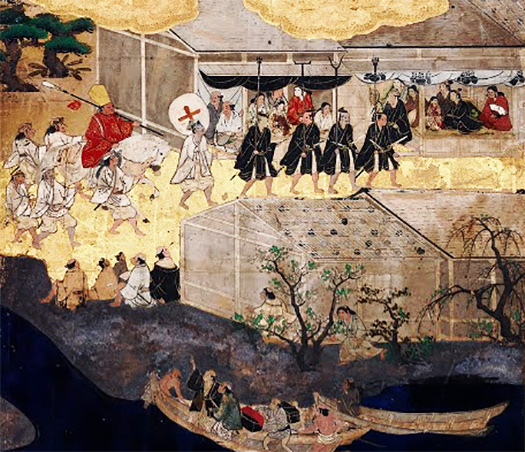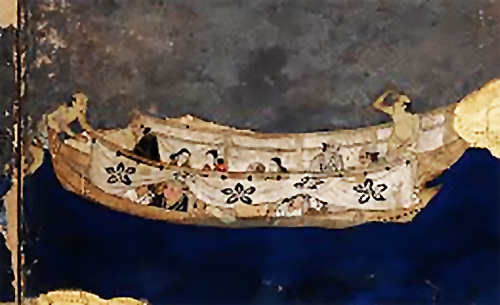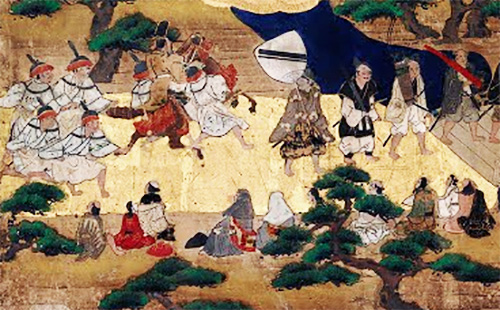


住吉大社の祭礼のなかでもこの神輿行列は格別だったのか、
江戸期を通じて経済活動のメッカであり続けた大阪商売の神さまらしく
賑々しい行列・見物ぶりに圧倒される思いがします。
16世紀日本に滞在していたポルトガルの宣教師・ルイスフロイスは
その著書「日本史」において、
「群衆は住吉大神の神輿に歓喜し〝千歳楽、萬才楽、平楽じゃ、平楽じゃ〟と
歌いながら進んでいた」と記載している。
ちなみにこの掛け声が訛って現在の「べぇら、べぇらじゃ」になったという。
まことに戦国の終結から平和の実現が歓呼されていたか。
この祭礼図屏風でも、行列の立派さと同時にそれを見物する人々の
この祭礼に託す歓喜ぶりが熱く伝わってくるかのようです。
上の写真では普段は軒を並べた店舗とおぼしき「桟敷席」から人々が
行列の様子に熱視線を送っている。まるでオリンピック声援並み(笑)。
桟敷席の架構は柱と横架材が田の字に組まれ、それがアーケード的に連続。
道路側には庇や幕が張られて、日射遮蔽まで工夫されている。豪華。
店舗は通常は通行者に見せるのが機能でしょうが、お祭りでは
「見せる」から機能が逆転して「見る」ことの有用性になっているかのよう。
そういう桟敷席は臨時的に金持ちの特権席だったことでしょう。
多くの女性をはべらせたお大尽ぶりが伝わってくるのは妬みか(笑)。
気がつくのは屋根が住吉の町家では草葺き屋根が多かったのに対して
平屋根が多く一部では石置き屋根が見られること。
その他の建物でも、草葺きではなく平板な屋根として描かれている。
柾葺きなどの板材が考えられるけれど、
近接する住吉と堺で屋根の葺き方が大きく変わっているのが不思議。
普通に考えると堺の方がアーケード的な商業施設っぽいので、
簡単に引火しやすい草葺き屋根は地域協定的に禁止していたのかも。
まさかほんの数キロで堺は風が強くて草屋根が持たなかった、とは考えにくい。
一方で現在の大阪住吉と堺の間には「大和川」が流れているけれど、
その支流か当時の海岸線か、あるいは運河ででもあるのか、
遊覧船を仕立てて見物している人々も多く見られる。
こちらも水夫を使役して、お大尽たちが屋形船を楽しんでいる。
暑い盛りの神輿見物、涼しい船の上から楽しむ特等席見物。
それ以外の沿道にはたくさんの見物客が座り込んでいる。
神輿行列の人々は「べぇら、べぇらじゃ」と掛け声に拍子を合わせて
歌い踊りながら進んでいるように見られます。
住吉大社の「住吉祭」神輿渡御の令和元年のルート案内は以下の図。
おおむね7kmという行程は江戸初期と変わらないのでしょう。

住吉祭は7月31日に大阪市の住吉大社で行われる大阪三大夏祭りひとつ。
おはらいとも呼ばれ住吉大社の夏祭りの一部あるいは夏祭りそのものを指している。
『住吉大社神代記』によれば淵源は奈良時代にも遡ることができ、
六月の御解除(みはらえ)として恒例的に行なわれていたとされる。
簡単に千年を超える伝統がそこかしこに存在するのですね。関西恐るべし。
English version⬇
[Mikoshi Kenbutsu Pier / Pleasure Boat / Japanese Good House Special Edition ㊱-4]
Was this portable shrine procession exceptional in the festival of Sumiyoshi Taisha?
Like the god of Osaka business, which has been a mecca for economic activities throughout the Edo period
I feel overwhelmed by the lively procession and sights.
Luis Frois, a Portuguese missionary who was staying in Japan in the 16th century
In his book “History of Japan”
“The crowd rejoiced at the portable shrine of Sumiyoshi Ogami,” Chitose-raku, Mansai-raku, Heiraku, Heiraku-.
I was singing and proceeding. ”
By the way, it is said that this shout became the current “Bella, Bellaja”.
Was the realization of peace really cheered from the end of the Warring States period?
Even in this festival folding screen, the people who see it at the same time as the procession is splendid
It seems that the joy of entrusting this festival is enthusiastically transmitted.
In the photo above, many people are usually from the “box seats” where the eaves are lined up.
I am enthusiastic about the procession. It’s almost like the Olympics (laughs).
Pillars and horizontal members are assembled in the shape of a rice field in the frame of the pier seat, which is continuous in an arcade.
Eaves and curtains are put up on the road side, and even the sun is shielded. Luxury.
Stores usually function to show passers-by, but at festivals
It seems that the function is reversed from “show” and “see” makes it useful.
Such a pier seat would have been a temporary rich privileged seat.
Is it envy that you can feel the great effort that made many women sick (laughs)?
I noticed that there were many thatched roofs in Sumiyoshi’s townhouses.
Some stone roofs can be seen.
Other buildings are also depicted as flat roofs rather than thatched roofs.
Board materials such as shavings are conceivable, but
It is strange that the roofing method has changed significantly between Sumiyoshi and Sakai, which are close to each other.
Sakai is more like an arcade-like commercial facility when you think about it normally.
Thatched roofs, which are easily ignited, may have been banned by regional agreements.
It’s hard to imagine that Sakai was windy and didn’t have a grass roof just a few kilometers away.
On the other hand, the “Yamato River” runs between Sumiyoshi, Osaka and Sakai.
Is it a tributary, the coastline of the time, or a canal?
Many people are watching by tailoring a pleasure boat.
The sailors are also used here, and the great crew are enjoying the houseboat.
A hot shrine tour and a special seat tour that you can enjoy from the cool boat.
Many spectators are sitting along the other roads.
The people in the portable shrine procession beat the shout, “Bella, Bellaja.”
It seems to be singing and dancing.
The figure below shows the route guidance for the first year of Reiwa at the “Sumiyoshi Festival” of Sumiyoshi Taisha.
The journey of about 7km is probably the same as in the early Edo period.
The Sumiyoshi Festival will be held on July 31st at Sumiyoshi Taisha Shrine in Osaka City. One of the three major summer festivals in Osaka.
Also called Oharai, it refers to a part of the summer festival of Sumiyoshi Taisha or the summer festival itself.
According to “Sumiyoshi Taisha Shintoki”, Fuchigen can be traced back to the Nara period.
It is said that it was held regularly as the cancellation of June (Miharae, also known as the South Festival).
There are easily over a thousand years of tradition here and there. Kansai is scary.
Posted on 7月 9th, 2021 by 三木 奎吾
Filed under: 住宅マーケティング, 日本社会・文化研究







コメントを投稿
「※誹謗中傷や、悪意のある書き込み、営利目的などのコメントを防ぐために、投稿された全てのコメントは一時的に保留されますのでご了承ください。」
You must be logged in to post a comment.